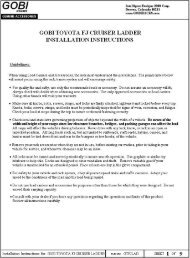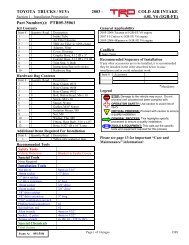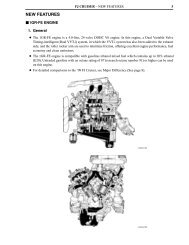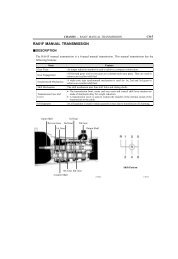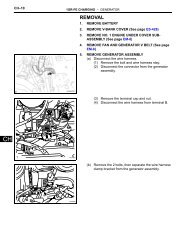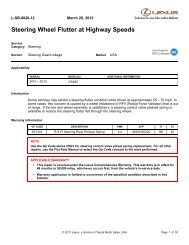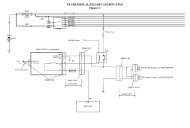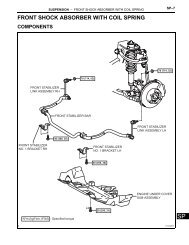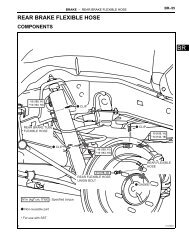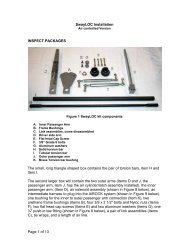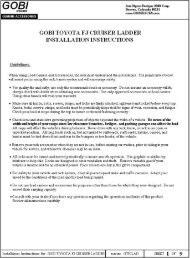TIP2252 Tech Tip WATER PUMP LEAKAGE – REPLACEMENT REQUIREMENTS ...
TIP2252 Tech Tip WATER PUMP LEAKAGE – REPLACEMENT REQUIREMENTS ...
TIP2252 Tech Tip WATER PUMP LEAKAGE – REPLACEMENT REQUIREMENTS ...
You also want an ePaper? Increase the reach of your titles
YUMPU automatically turns print PDFs into web optimized ePapers that Google loves.
<strong>WATER</strong> <strong>PUMP</strong> <strong>LEAKAGE</strong> <strong>–</strong> <strong>REPLACEMENT</strong> <strong>REQUIREMENTS</strong> TIP 2252<br />
NOTE: Coolant stains or deposits on the water pump housing at the location of the drain pocket end<br />
caps should be considered as normal.<br />
Consider this: Coolant stains or deposits on the water pump housing may be considered more<br />
relevant as a need or recommendation for a coolant flush, in comparison to the need to replace a<br />
water pump.<br />
The engine coolant is the lubricant for the water pump. Therefore, coolant will flow between the seal and<br />
the shaft. Under normal operating conditions, the coolant that flows between the seal and shaft will<br />
evaporate before reaching the exterior of the water pump housing. However, it is possible for the coolant<br />
to reach the exterior of the water pump at the location where the shaft extends.<br />
The following are contributing factors that may allow coolant to be seen on the exterior of the water<br />
pump at the location where the shaft extends<br />
• Ambient temperature - cold temperatures preventing the coolant from evaporating before it<br />
reaches the exterior surface of the water pump.<br />
• Ambient temperature - very cold temperatures will cause the materials used in the physical<br />
make-up of the water pump to expand and contract differently.<br />
• Driving routine - short drives with engine shut-off before reaching normal operating<br />
temperature.<br />
NOTE: Coolant stains or deposits observed on the exterior of the water pump housing at the<br />
location of the shaft extension should be considered as normal.<br />
Suggestion:<br />
Standards to determine the necessity to replace leaking water pump:<br />
a. When the complaint is “Engine temperature High”, “Coolant seen on the ground” with the condition of<br />
Coolant seen dripping / leaking from the water pump.<br />
1. Verify the customer’s complaint.<br />
2. Replace the water pump if you confirm the condition.<br />
b. When some other repairs are performed on the vehicle:<br />
1. Verify the “Add-On” repair conditions:<br />
• Coolant stain or deposits on the exterior of the water pump housing.<br />
• The coolant reservoir level is below the ‘L’ low level line (visible on most Toyota models)<br />
• There are no other signs or sources of a coolant leak.<br />
• Previous maintenance service (top up of fluids) was within the last six (6) months<br />
2. If all four “Add-On” repair aspects are met replace the water pump.<br />
If the last maintenance service date is unknown or was performed beyond a period of six (6) months and<br />
the coolant reservoir is below the ‘L’ low level, add coolant and monitor.<br />
Note: In matter of Warranty Standards please consult the WARRANTY Bulletin WAB 2067<br />
NOTE:<br />
Issue of this <strong>Tech</strong> <strong>Tip</strong> is to help in the trouble shooting of a specific condition.<br />
If a condition is described, it does not mean it applies to the vehicle you are working on.<br />
IT DOES NOT CONSTITUTE AN AUTHORIZATION FOR REPAIR.<br />
Page 2 of 2



